Specialized glass is finding its way into high-volume applications.
Dimitri Van Uytfange, Umicore Electro-Optic Materials
With the recent development of less costly uncooled infrared detector technology, expensive optics are among the remaining significant cost drivers. For many years, germanium has been the critical material for thermal imaging in the 8- to 12-μm wavelength range, which is used in a wide variety of defense and commercial applications. However, the costs associated with germanium lenses had prohibited a breakthrough for high-volume commercial systems.
Researchers and engineers at Umicore Electro-Optic Materials have developed a chalcogenide glass with a transmission range of 0.8 to 15 μm. The material, called Gasir, can be used for near-infrared as well as mid- and long-wavelength infrared applications.
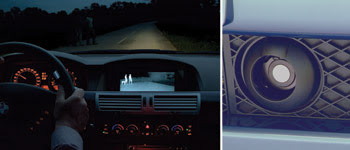
One application of chalcogenide glass is in the night-vision camera integrated into BMW’s 7 series automobiles. Courtesy of BMW.
One advantage of the material is that its germanium content — the most expensive of its constituents — is only 20 percent. It also is easier and faster to produce chalcogenide glass ingots than to grow single crystals of germanium. Together, these result in a less expensive starting material.
Importantly, the material is moldable: In one step, complex shapes can be developed without using traditional but expensive processes such as diamond turning or polishing. Molding significantly lowers cost and enables high production volumes.
Also in contrast to traditional processes, there is no additional cost for producing complex lens shapes such as aspheres or asphero-diffractives. This results in several benefits. First, a lens with a complex shape is no longer difficult to manufacture and, hence, is cheaper. Moreover, through smart design, one can reduce the number of lenses required in an optical setup. Besides savings in the material cost, one also can save on total system cost.
To produce the chalcogenide glass used as the basis for Gasir, ingots of up to 200 mm in diameter and 60 to 70 mm thick are placed in an automatic furnace. They are subjected to a thermal procedure that enables the reaction between the high-purity starting elements, homogenization, cooling and annealing.
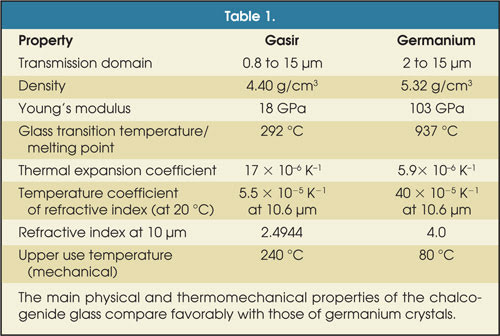 The properties of Gasir compared with germanium show the benefits of the former (Table 1). For example, the small change in refractive index with changes in temperature results in a small change of focal length, which in turn permits simple passively athermalized mechanical designs. This means that, besides the savings previously described, camera and sensor producers can reduce cost further by eliminating expensive athermalization measures in their cameras.
The properties of Gasir compared with germanium show the benefits of the former (Table 1). For example, the small change in refractive index with changes in temperature results in a small change of focal length, which in turn permits simple passively athermalized mechanical designs. This means that, besides the savings previously described, camera and sensor producers can reduce cost further by eliminating expensive athermalization measures in their cameras.
Temperature range
A second benefit of the chalcogenide glass is its working temperature range. Whereas germanium turns opaque at 80 °C, Gasir is transparent to at least 120 °C. It has not been tested for higher temperatures because 120 °C is the limit of thorium-free, high-efficiency coatings.
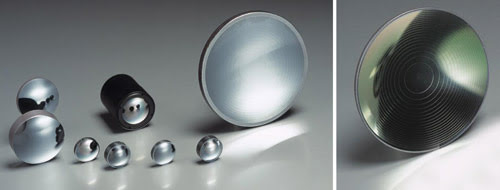
The low-germanium glass Gasir can be molded into a variety of shapes in a simple, single-step process (left). By molding the lenses instead of turning them with single-point-diamond systems, accurate diffractive patterns can be made for low cost (right).
Umicore’s molding process makes possible the creation of spherical, aspherical and asphero-diffractive lenses with accurate surface precision. The regularity of a surface can be better than 0.5 fringes, which is very good for a component working in the infrared; the total shape defect can be better than 1 fringe. The surface roughness of molded lenses is comparable to that of polished optics with a roughness of 10 nm.
One challenge for high-volume optics is to ensure good quality in the final assembly. Therefore, all of the produced assemblies are examined at the end of the production line with a custom modulation transfer function test (Table 2).
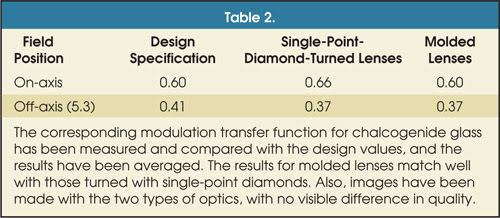 Commercial off-the-shelf modulation transfer function test equipment is unsuitable for evaluating infrared optics because its dependence upon linear arrays can lead to testing cycle times for a single-lens assembly of more than an hour. By appropriate use of automation and dedicated equipment for the single-lens assembly, a cycle time of less than two minutes per assembly is possible.
Commercial off-the-shelf modulation transfer function test equipment is unsuitable for evaluating infrared optics because its dependence upon linear arrays can lead to testing cycle times for a single-lens assembly of more than an hour. By appropriate use of automation and dedicated equipment for the single-lens assembly, a cycle time of less than two minutes per assembly is possible.
The major drawback of chalcogenide glasses compared with germanium is that they exhibit higher chromatic dispersion. For this reason, optics using infrared glass must be achromatized using diffractive or binary surfaces.
Accurate diffractive patterns
Prior to the use of molding technology, these surfaces could be created only via single-point-diamond turning, which is an expensive process. This is the primary reason that lenses made of chalcogenide glass have been used only rarely in thermal imaging systems, even though this type of material was invented several decades ago. However, by molding the glass, diffractive patterns can be added at no further cost to the consumer. The accuracy of molding diffractive patterns is very good, with a step-height regularity of >0.2 μm.
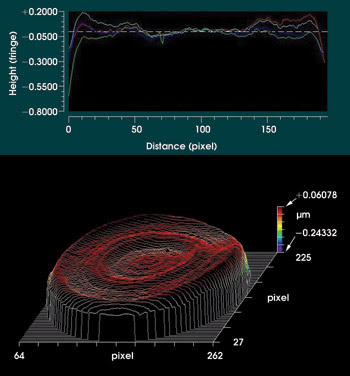
Interferometric controls of a typical molded Gasir lens show the quality achievable with the molding process, including peak-to-valley surface defects of <1.0 fringe (top) and surface regularity of <0.5 fringe (bottom).
A manufacturing facility in Quapaw, Okla., produces Gasir assemblies for use in night-vision systems in BMW automobiles. The system, developed by Autoliv Inc., based in Stockholm, Sweden, is the first in a series of high-volume applications that could benefit from new optical materials such as this. Such materials will be used in thermal imaging and smart-sensing applications, including fire fighting, thermography and security, and in car sensors for pedestrian detection, smart air-bag deployment, air conditioning control and intrusion alarm.
Meet the author
Dimitri Van Uytfange is application manager for finished optics at Umicore Electro-Optic Materials in Olen, Belgium; e-mail: [email protected].